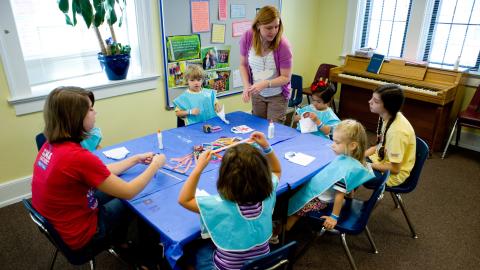Your heart is in the right place, and you’ve prepared carefully. So everything is certain to go smoothly, right? Not necessarily. As one experienced teacher put it, creating a disciplined environment to ensure optimal learning requires equal parts of technique and personality.
What about that personality thing? Teachers come in all varieties. Some are warm and nurturing; others are charismatic and energetic. Some are good storytellers but don’t like singing; some love doing arts and crafts but feel less confident leading games and group activities. In the same way, some are naturals at creating a disciplined learning environment, while others have to work at it. If you’re in the latter group, don’t lose heart. It doesn’t mean that you shouldn’t be teaching—you can be sure that God will use you.
One older teacher, reflecting on a Sunday school class he taught in his younger years, remembers it as a disaster. The kids seemed to run all over him, his plans ran amok, and chaos was the norm. So he was surprised when, meeting a former student from that class years later, the young man said, “I remember you! You were such a cool teacher. I loved going to Sunday school. And you really showed me Jesus’ Spirit—you were so patient with us.”
God works in mysterious ways! You may worry that the seeds you’ve planted will be choked out, but God, as always, is in control.
When teaching feels more like hanging on for dear life than sailing on a lovely lagoon, these tried and true techniques shared by experienced teachers might help you restore quiet waters to your room:
- Gear your teaching to children’s attentions spans, allowing about one minute per year of age for each activity. (Expecting a five-year old to listen to a ten-minute story without involving him in movement or response as part of the story time could be an invitation to trouble.)
- Match your teaching to kids’ interest level. Bored or frustrated children inevitably look for something else to do, and usually that’s not a good thing! Know the characteristics of your age group, and make sure your activities are varied and your vocabulary and expectations appropriate.
- Clearly communicate a few basic expectations to the kids—and then be consistent in enforcing them. You cannot assume children know what you expect, so state the things that are important to you at the outset. (Keep your list of rules short or you’ll be spending all your time being a traffic cop instead of a teacher.)
- Involve the group by communicating “big picture” expectations and goals; then invite their cooperation in creating and observing rules. (For example, you might agree on a secret code that only you and the children know about—like “XYB” (examine your behavior)—that cues kids to check their behavior.)
- Strike a balance between routine and variety. Routines kids can count on, such as opening rituals, theme songs, and prayer times, give everyone a sense of security and add stability to the program. Variety in activities keeps everyone involved and interested. (So for example, vary the way you do your routine prayer time. Invite different children to lead the opening prayer—or supply motions to it. (DWELL Curriculum session plans suggest a variety of activities, while always following the same step-by-step format that helps kids know what’s coming.)
- Respect children’s individuality and preserve their dignity. Shouting, physical restraint, and singling out offenders cause fear, shame, and feelings of violation. If a child is disruptive, speak to that child in private to get at the root of the problem. Keep your voice down—the louder you speak, the louder your children’s voices tend to become.
- Use eye contact as a way to manage behavior. A long, searching gaze, a quick glance of approval, eyes crinkled in amusement or widened in amazement can have a powerful effect on the mood in your space.
- Anticipate problems and adjust for them. (Remember your motto: “prepare and prevent!") Give Tony the talker a hands-on role; seat Diana the dreamer away from the window, separate chatty best friends.
- Arrive early. Organize details and materials ahead of time so that you can be there to greet everyone by name and with a smile. A hurried teacher who arrives when kids are already gathered in the room waiting for things to happen is a teacher with two strikes against her.
- Expect the best. Rejoice over good behavior. Catch kids being good and reinforce that behavior.
What other teaching techniques work for you in the classroom? Share below!
This post contains an excerpt from Dwelling. Reprinted with permission. © Faith Alive Christian Resources

Let's Discuss
We love your comments! Thank you for helping us uphold the Community Guidelines to make this an encouraging and respectful community for everyone.